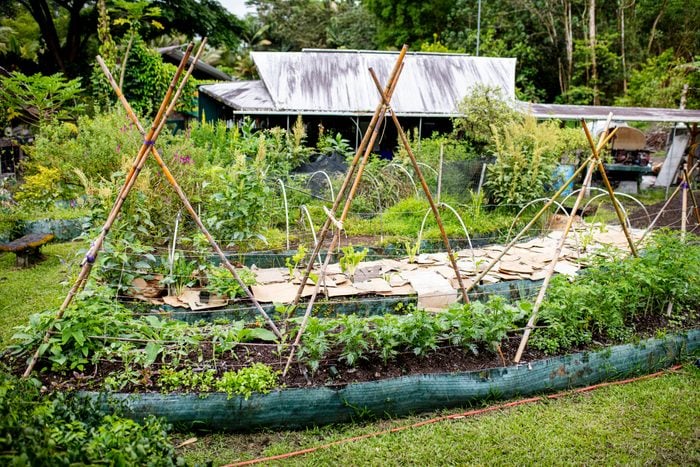What To Know About a Permaculture Garden
Updated: Mar. 06, 2024

Work with nature, not against it, by starting your own sustainable permaculture garden. Check out these expert tips and strategies anyone can follow.
Permaculture gardening is the only way I garden. It’s about building a healthy, sustainable micro-ecosystem.
Permaculture is a form of regenerative agriculture the works in harmony with nature. It’s the way our ancestors grew their food and ornamentals. And it’s a brilliant way to live more sustainably, giving back to the planet instead of just taking from it.
I grow a large percentage of my own food organically, using sustainable permaculture ideals. Think about it: Nature did well without human intervention for millions of years. Edible plants grow prolifically in the wild without someone around to trim them, remove weeds and spray chemicals on them. So mimicking nature in your garden is just common sense.
While you’re at it, also learn: How to use lunar phases for planting and harvesting.
On This Page
What Is a Permaculture Garden?
An agricultural system rooted in holistic, sustainable practices. The term permaculture, coined by Australians Bill Mollison and David Holmgren in the 1970s, blends “permanent” and “agriculture.”
Permaculture gardening involves companion planting for biodiversity and plant and soil health, using sustainable, organic practices, and nurturing your space. It really doesn’t matter if you have 50 acres or five containers, you can still practice permaculture principles.
Three things summarize a permaculture garden and lifestyle:
- Care for the earth: Be considerate of your growing space and everything that resides within it. Build a diverse ecosystem, don’t use chemicals and aim for a light footprint.
- Care for people: In gardening terms, this core principle means not using anything in your garden that’s potentially hazardous to health. Take time in your natural space to connect with nature, relax and take care of yourself.
- Only take your fair share: In my garden, I interpret this as taking what my family needs and sharing the rest. I donate the surplus to local folks who need help, as well as to food banks. And I’m happy to share the leftovers and the blemished/damaged crops with the wildlife. I set it out in the garden, away from the still-growing crops, and let nature take its fill. Anything that isn’t taken gets turned back into the soil to nourish it.
Permaculture gardens can thrive in lots of climates and settings, from a small urban lot to a large rural farm. Plants chosen are often native to the region and appropriate for the local climate or growing zone, further promoting sustainability.
Pros and Cons of a Permaculture Garden
For me, there really aren’t many cons, just lots of lovely benefits.
I don’t mind the time investment because I love being outdoors. The physical work and just immersing myself in green space is relaxing and peaceful.
Pros
- Sustainability: Permaculture gardens focus on minimizing waste, using resources efficiently and promoting biodiversity. These align with the principles of sustainability.
- Low maintenance: Once established, permaculture gardens require less maintenance than traditional gardens, because plants are chosen to support each other.
- Soil health: Permaculture practices improve soil health by maintaining a natural balance of nutrients and microorganisms.
Cons
- Initial setup: This requires planning and effort.
- Time investment: It takes time for the garden to mature and establish the ecological relationships between plants.
How To Start a Permaculture Garden
You don’t need any special tools or materials to start!
Choose your plants
Figure out what plants you want to grow. Use companion planting to deter pests, attract pollinators and predatory insects, and boost the health of other plants.
Choose a variety of plants that can coexist in a mutually beneficial way. And think of a natural ecosystem: Tall trees provide shade for understory plants, which in turn cover the ground, preventing soil erosion. Choose plants that thrive in your area.
Design your garden
Study your growing space. Which area gets the most sun? How about shade? Are there particularly dry or wet areas? Are some spots more sheltered from the wind than others?
Is the whole space flat or do you have slopes and valleys? Do you already have tall plants that can act as a windbreak or a natural trellis? Lay out the garden so that plants with similar needs grow together.
Prepare the soil
Healthy soil is fundamental to a successful permaculture garden. Start composting kitchen scraps, leaves and other organic materials to enrich your soil.
And don’t dig excessively. In an ideal permaculture garden, you don’t disturb the soil more than necessary. Instead, add amendments, compost and mulch to the top of the soil and let it break down naturally.
You can also make strategic planting decisions like using beans, peas or other legumes as nitrogen fixers to boost your soil’s nitrogen content if it’s lacking. Other natural amendments include cover crops, nettle or manure tea and seaweed.
Plant
Plant your garden according to your design, respecting the sunlight and water needs of each plant. Remember, the goal is to create a symbiotic relationship between the different plants in your garden, so place them where they can best support each other.
Use mulch and water
Mulch retains moisture, suppresses weeds and adds organic matter to the soil. Apply a layer of organic mulch around your plants. ( Explore why mulch catches fire.)
With watering, permaculture gardens often rely on natural rainfall and dew. You can manage this by incorporating features that collect, store and distribute water, like rain barrels or swales. Use drip irrigation to water consistently at ground level.
Next: Figure out if hugelkultur raised bed is better than a traditional bed for your garden.
